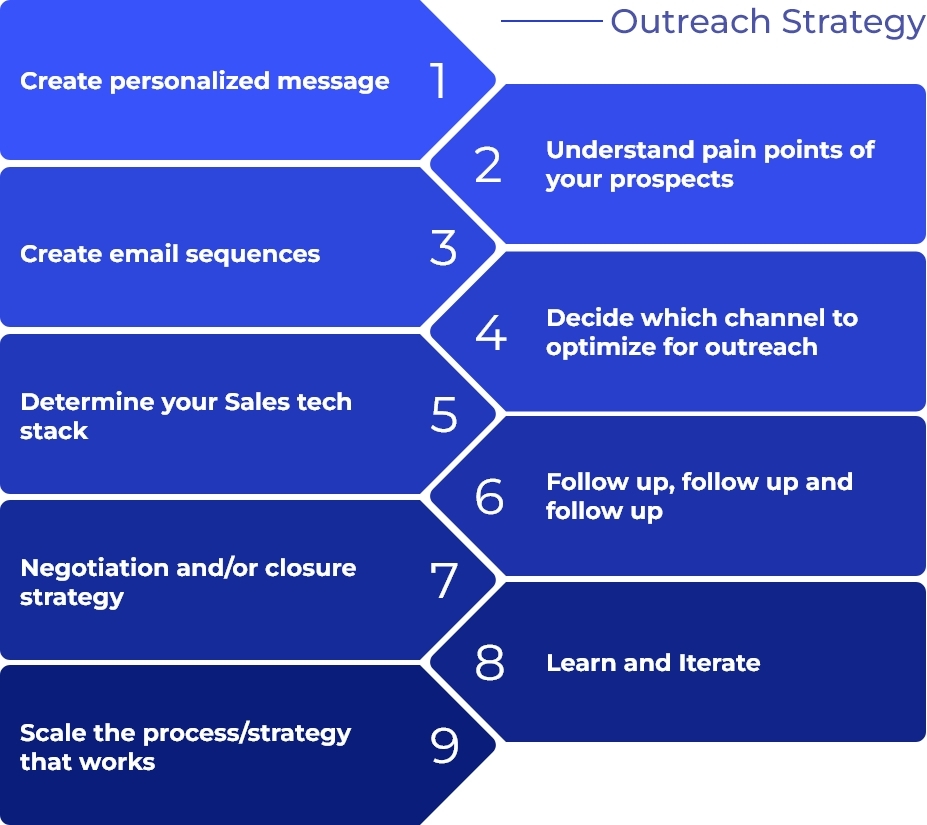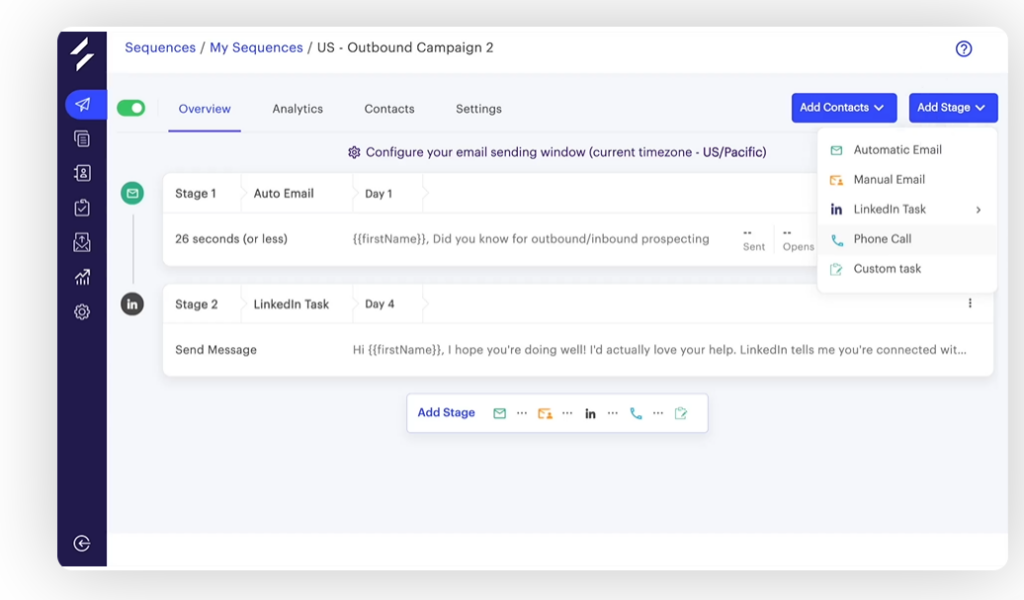What is Outbound Sales
An SDR (Sales Development Representative) reaches out to a prospective customer, who hasn’t yet taken an interest in the product that the company provides. This is basically outbound sales.
It is a process that involves reaching out to people who either know your company or do not. Here, people do not search and come for you. Rather you go, find them and make them your customers. This is one of the main differences between Outbound and Inbound sales.
For further information, check out this blog- Why is Outbound sales going to be an important strategy in 2023?
What are the steps involved in the Outbound Sales process?
As you might have figured out, a series of steps are necessary in order to successfully execute an outbound strategy. These steps encompass the outbound sales process.
Let’s try and understand the important steps that you have to take to successfully execute the outbound sales process.
Define your ICP clearly
You cannot, and should not, sell your product to everyone. In a B2B SaaS business, it’s crucial to identify which firm (customer) will stand to benefit most from the product. Hence, defining your ideal customer profile (ICP).
Defining your ICP is the first and most important step. It’s about getting clarity about who your target company is and making sure that your product will solve their pain points.
ICP is generally designed based on certain factors, like-
- Operating Industry (e.g.- e-commerce, Technology, Retail, etc.)
- Geographical location (e.g.- APAC region, US, etc.)
- Number of years since the company has been in existence
- Number of employees (e.g.- not less than 500 verified LinkedIn employees)
- Revenue (e.g.- >$100 million in annual sales)
Discover your target accounts
Imagine you have got a sales funnel that is giving you a steady flow of high-quality leads. Furthermore, every prospect is fit to your ideal customer profile. Let’s take it to the next level- each deal converts into a customer and, revenue!
Sounds too good to be true? Well, this is possible only if your SDRs know how to discover your target accounts. The best way to do this is to leverage tools like LinkedIn and Crunchbase.
Having this strategy early in your outbound sales process is key. It’s because you’ll get to know exactly which type of firm and which customer/buyer persona will benefit from your product.
Identify the decision-makers
Approaching the right people is crucial. It’s because if you don’t, then expect to hear ‘No’ all the time as they only have the authority to say so. Therefore, identify and approach the right decision-makers.
A decision-maker has the power to determine whether or not to move on with a project. To avoid the hassle, identify the decision-makers first as this will increase your chances of getting a yes.
Typically, there are 3 levels of decision-makers that an SDR particularly targets.
- C-suite,
- VP/Director, and
- The user.
SDRs target each level of decision-makers based on the company size and also their role. For example, a VP may not be the decision-maker in a small start-up. Rather, the founder/owner is the decision-maker.
Therefore, having a clear understanding of the decision-makers in your target accounts will allow you to create the right messaging for each level.

Set up an outreach strategy
Now that you have a clear understanding of your target accounts and the decision-makers within, you can start creating an outreach strategy that is focused on driving and ultimately closing business.
The outreach strategy is designed to generate business leads and sales opportunities by having a specific set of activities that bring in new deals and customers.
Form personalized message
Yes, this may seem like a no-brainer, but extremely important. Form personalized messages that you want to share with the identified accounts. The benefit is that the receiver of the message will understand that you are genuinely interested in doing business with them.
Understand pain points thoroughly
This is unskippable! It may be possible to impress a prospect with a really great message, but you will never be able to close the deal without understanding the pain points the decision-maker currently has.
Create email sequences

Outreach is not limited to cold calling or door-to-door sales. Today, with access to plenty of tools to identify names, emails, social media, etc., SDRs can easily carry out wide outreach. An email sequence helps with this.
It is an automated series of emails that usually are task-based and are sent out at a fixed time. Creating email sequences will be easy if you have a clear understanding of the target audience, which by now you should have.
However, there’s one point to remember here- not every approach will work for every prospect. Personalize these emails to suit the prospect to whom you’re sending to. Let them know that they are not receiving the emails from a bot but from a real person.
Suggested Read: Book 5 meetings in a day with this Cold email checklist.
Decide which channel to optimize for outreach
Don’t try to optimize every available channel for outreach. Instead, find the one in which your prospects are the most active. Go where your audience is.
The channel may differ at any given point in time. The decision to opt for a specific channel should be based on where your prospects are, their preferences, the nature of the business, etc.
What is your sales tech stack going to be?
Tech stack plays an important role in the success of an outreach strategy. A sales tech stack helps SDRs to spend less time administrating and more time selling. Leverage the tools available to you and invest in the one that can help you meet your objectives.
A solid sales tech stack can include the following tools:
- CRM like HubSpot, Salesforce, Pipedrive, etc.
- Prospecting and Lead generation tools like
- Sales automation tools like
- Sales reporting and management tools like
- Demo tools like
- Sales Engagement tools like Salesgear, Outreach, Salesloft, etc.
- Sales enablement tools like
Follow up, follow up and follow up
According to Marketing Donut, after the meeting, at least five follow-up calls are necessary for more than 80% of sales. However, about 56% of the SDRs do not do that. No wonder, many aren’t able to fruitfully close the deals.
Follow up with the prospects consistently (but don’t push) to keep the conversation they had with you at the top of their minds.
Want to know more about follow-ups? Check out this amazing blog on ‘Best Interval between your sales follow-ups’
Negotiation and/or closure strategy
This refers to the process of developing a plan for closing deals or negotiating contracts with potential clients. This strategy should include tactics for addressing common objections, handling pricing negotiations, and identifying key decision-makers.
The negotiation and/or closure strategy should also consider the needs and preferences of the potential clients to ensure that the deal meets their requirements.
Examples-
- Offering discounts or special pricing to close deals
- Focusing on demonstrating the value of the product or service to potential clients
- Identifying and engaging decision-makers in the buying process
- Providing personalized solutions to meet the unique needs of potential clients
Learn and Iterate
This step involves continuous learning and refinement of the outbound sales strategy. This may include analyzing sales data, reviewing customer feedback, and evaluating the performance of the sales team.
Based on the findings, the strategy should be adjusted and improved to address any weaknesses and capitalize on strengths. This step is critical for keeping the outbound sales strategy relevant and effective in a constantly evolving market.
Examples-
- Tracking key performance metrics such as conversion rates, response rates, and sales cycle length to identify areas for improvement
- Analyzing customer feedback to identify common pain points and areas for improvement
- Conducting regular training and coaching sessions for the sales team to improve their skills and knowledge
- Experimenting with different messaging and targeting strategies to find the most effective approach
Scale the process/strategy that works
Once a successful outbound sales process/strategy has been identified through learning and iteration, it should be scaled up. This may involve expanding the sales team, automating some processes, or investing in more resources to support the sales process.
The goal is to maximize the efficiency and effectiveness of the sales process/strategy to achieve the desired outcomes, such as revenue growth and customer acquisition.
Examples-
- Expanding the sales team to cover more geographic regions or customer segments
- Automating some aspects of the sales process, such as email outreach or lead scoring
- Investing in marketing and advertising to generate more leads and opportunities
- Developing partnerships with other companies to leverage their sales channels and reach new customers.
Pro tip: Building a 10x outbound engine
Common customer Objections and how to overcome them
Any concern a potential customer expresses regarding a hindrance to their ability to purchase from you is a sales objection.
This is where most sales reps falter as they do not prepare for these roadblocks. They try to grapple with the situation and end up sounding robotic and insincere. Take a look at the following common objections, and learn how to overcome them.
“I’m talking to some other providers as well but your product is relatively expensive.”
The most common objection to sales is a price objection. Try having a conversation that makes the prospect realize your tool’s value for their business.
“Your solution is really good, but I don’t need it this time”
The problem here is that either they aren’t aware they need a solution or that there’s a tool to solve their pain point. It comes down to you how you present your product. Make them aware that your tool is exactly what they need right now.
“We are currently using the xxx tool and it manages all our data very well.”
The prospect might be using one tool to help with their challenges. In such cases, it becomes a little tricky. You would have to sit them down and show how their pain points can be solved much more easily and quickly using your product.
Final thoughts
People who experience pain, search for a solution and find you. However, there are many other people who might be experiencing similar pain but don’t know about you. In such cases, you would want to go out, find such people, and tell them about the solution that you have for their problem.
This is nothing, but the – outbound sales process. If you want to build a long term and successful outbound sales strategy, then follow the steps and make surw that you learn, refine and scale your process on a continuous basis.